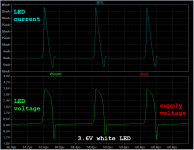Super Power JOULE THIEF - All
Only one of each of battery (1.5V), transistor, resistor, ferrite and LED.
No capacitor.
Is this an autotransformer?
Is it oscillating to get the transformer to operate?
Only one of each of battery (1.5V), transistor, resistor, ferrite and LED.
No capacitor.
Is this an autotransformer?
Is it oscillating to get the transformer to operate?
Does it really work?? Or to say better does component looses not exceed energy gained
Last edited:
the LM3909 IC flashes a 2.2V LED using a 1.5V AAA cell, an IC, and an electrolytic capacitor.
The surprising thing about the Joule Thief is that it flashes a 2.2V LED using a discharged AAA battery whose terminal voltage is only 0.8 - 0.9 volts. It's not a buck SMPS, it's a .......... ..........
The surprising thing about the Joule Thief is that it flashes a 2.2V LED using a discharged AAA battery whose terminal voltage is only 0.8 - 0.9 volts. It's not a buck SMPS, it's a .......... ..........
No thread on this should go without linking the originator of the name, who also gives his source for the circuit. Make a Joule thief.
It does not GAIN energy.Does it really work?? Or to say better does component looses not exceed energy gained
It transforms the voltage.
If the voltage gain were exactly 2times and the efficiency were 100%, then the input current would be 2times the output current.
If the efficiency is 50%, then the input current would be 4times the output current.
The three example efficiencies are from 57% to 79% (wiki link), realising a current drain of 3.5times for the BC549 to 2.5times for the ZTX650, if the input voltage is exactly half the output voltage.
If the high current drain on the battery results in a lower input voltage, then the current drains becomes even higher.
A very good way to completely discharge an already low battery.
Last edited:
Google offered up links to LTSPICE simulations of the Joule Thief. I grabbed one, cranked down the battery voltage to 0.6V, and ran it with a white LED whose forward voltage is 3.6V according to its datasheet (Nichia NSPW500BS). Thankfully the simulation agrees with real-life results on the bench: an 0.6V battery cell indeed can flash a 3.6 volt LED by means of a Joule Thief.
_
_
Attachments
This JFET based one looks quite interresting, a bit different from the 'standard' circuit : https://www.youtube.com/watch?v=Fzww6yPQMrg
- Status
- Not open for further replies.
- Home
- Amplifiers
- Power Supplies
- How does the "Jewel thief" work?
